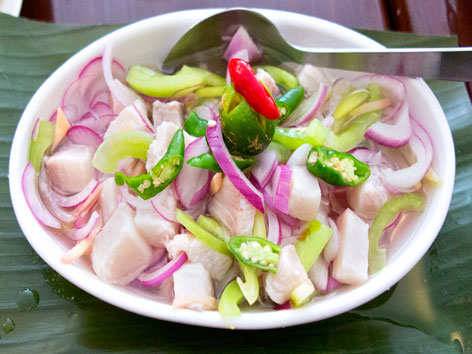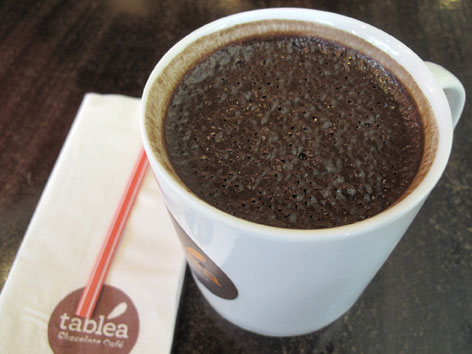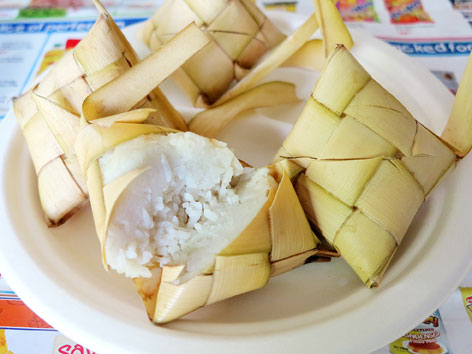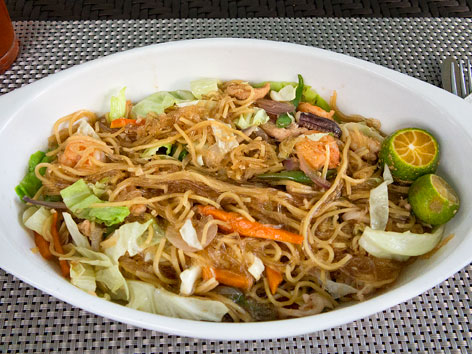Quintessential Cebu: What to Eat
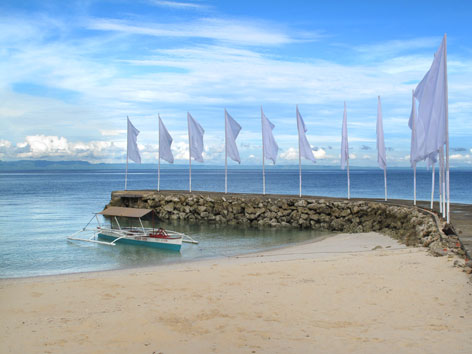
This destination spotlight crosses the globe to Cebu, in the central Philippines, an appealing destination for business travelers, beachgoers—and people who like to eat. Our writer, a Cebu resident, demonstrates why in our 20-dish-strong Cebu guide. Here’s a taste.
Camotes Islands, Cebu, two hours by boat off the mainland. Photos by Mona Polo
Located in the center of the 7,107 islands that make up the Philippines, Cebu (“se-boo”) is a tropical playground disguised as a business hub…or is it the other way around? Cebu the island—the province and cosmopolitan capital city share the same name as well—is 156 miles and just 28.8 miles at its widest, so travelers for pleasure or business have everything close by: white-sand beaches, exclusive five-star resorts, a bustling business district, world-class dive sites, important historical landmarks, shopping malls and food courts (ahem). Of course, visitors here are horribly spoiled for choice when it comes to nature and the outdoors—but we’d say the same for the wide range of local food reflecting Cebu’s diverse background, with influences from Indonesia and India, China and Spain.
Despite the many international options on Cebu today, traditional or native Cebuano dishes passed from mother to child still hold their ground as daily fare, reflecting the island’s rural roots. These dishes lean toward the simple in terms of preparation and presentation, relying on super fresh meat, fish, and produce, and eschewing complicated flavors in favor of subtle aromatics: Savory plates are often adjusted to taste with patis (soy sauce), suka (vinegar), and bird’s eye chilis, all three ever-present on dining tables. From the bucolic utan bisaya (a vegetable soup), colorful binignit (a creamy fruit stew), hand-stirred sikwate (hot chocolate), and Anthony Bourdain’s favorite lechon (roast pig), Cebu’s quintessential eats offer plenty for carnivores and sweet tooths alike. Eating is an institution and a past time here—not even a trip to the beach is without some noshing, thanks to portable snacks like puso (“hanging” rice wrapped in coconut leaves) and pilit (rice cakes wrapped in banana leaves).
It’s time to dig into Cebu. Mangaon ta bai! (Let’s eat, friend!)
Lechon
Lechon Cebu is a young pig stuffed with a secret mix of herbs and spices (usually including star anise, spring onions, lemongrass), skewered on a bamboo pole and roasted whole over hot coals. The hallmark? It doesn’t need sauce! This stuff is so mouth-wateringly delicious that all you really need with it is rice—lots of it.
Read more about lechon Cebu in Cebu.
Binignit
Binignit is a sweet, creamy, colorful Cebuano stew of fruit and tubers that’s eaten as a snack or dessert. Vegetables for dessert? Indeed. Ingredients can vary, but at its most basic, it’s a merry mix of cubed saba (cooking bananas), jackfruit, taro root, sweet potatoes, purple yam, milled or whole grains of sticky rice, and landang, palm-flour jelly balls (similar to sago or tapioca pearls). Everything is gently stewed in coconut milk with some muscovado sugar, or unrefined brown sugar. You’ll want to savor this creamy, starchy, fragrant stew by the spoonful.
Read more about binignit in Cebu.
Kinilaw
Kinilaw, also called kilaw, is raw, cubed fish in a vinegar-based dressing, usually eaten as an appetizer. The closest comparison is ceviche, except ceviche uses citrus fruit like lemons or lime to dress the seafood while kinilaw is made with coconut vinegar, plus garnishes like garlic, onions, ginger, and chiles. The best versions rely upon good vinegar and fresh raw fish—connoisseurs say it should be “washed,” not soaked, in the vinegar, turning the pink flesh white and just slightly opaque. Fortunately, both of these things are abundant in Cebu.
Read more about kinilaw in Cebu.
Sikwate
The Cebuano version of hot chocolate, sikwate is possibly the closest you’ll get to drinking pure, raw chocolate. It starts with tableya de cacao (literally “tablets” of cacao), made from cacao (cocoa) beans that are dried, roasted, milled, and then hand-formed into tablets. The tableya are boiled with water in a special jug, and then frothed using a batirol, a wooden instrument rolled between the hands to release the cocoa butter (and produce froth). Finally, sugar and milk are added, resulting in a sweet, smooth, deliciously rich hot chocolate drink.
Read more about sikwate in Cebu.
Puso
Puso is rice wrapped and boiled in a triangular casing made of woven coconut leaves—also called hanging rice, as the packets are often picturesquely hung in bunches using the long ends of the leaves. It’s an icon of Cebuano street food, for reasons both delicious and practical: The organic casing imparts a unique leafy flavor to the rice, which is compact and dense enough to be eaten straight out of the leaves, sans spoon and fork. Then there’s the cleanliness factor: Wrapped in the leaves, the rice is protected from flies and human hands in open-air eateries. A portable essential.
Read more about puso in Cebu.
Bam-i
A stir-fried Cebuano noodle dish that uses both egg and bean thread noodles, bam-i is closely related to Indonesian, Malaysian, and Singaporean noodle dishes likely brought over by immigrants from Fujian, China. It’s rich and filling, with its base of noodles plus 10 to 15 ingredients comprising meat (bits of pork and pig liver), poultry (shredded chicken breast), seafood (shrimp and squid), herbs, and veggies, including the local tengang daga (“rat’s ear”) mushroom. Perfectly satisfying with a squeeze of limonsito.
Read more about bam-i in Cebu.
Budbud pilit
Budbud is a rice cake snack or dessert wrapped in banana leaves, while pilit, meaning “to stick,” refers to the variety of glutinous/sticky rice that’s used in budbud pilit. It’s the simplest item in the Filipino (sweet) rice-cake universe, using just coconut milk, sugar, and salt as flavoring agents. The rice is cooked over low heat before being wrapped in wilted banana leaves and steamed, with the leaves imparting a distinct aroma as well as a greenish tint. A heavenly snack, particularly when paired with local mangga (mangoes) and rich, chocolaty sikwate.
Read more about budbud pilit in Cebu.
Check out Eat Your World’s full Cebu food guide for details on these highlights and more, plus How to Burn It Off and Where to Stay.




